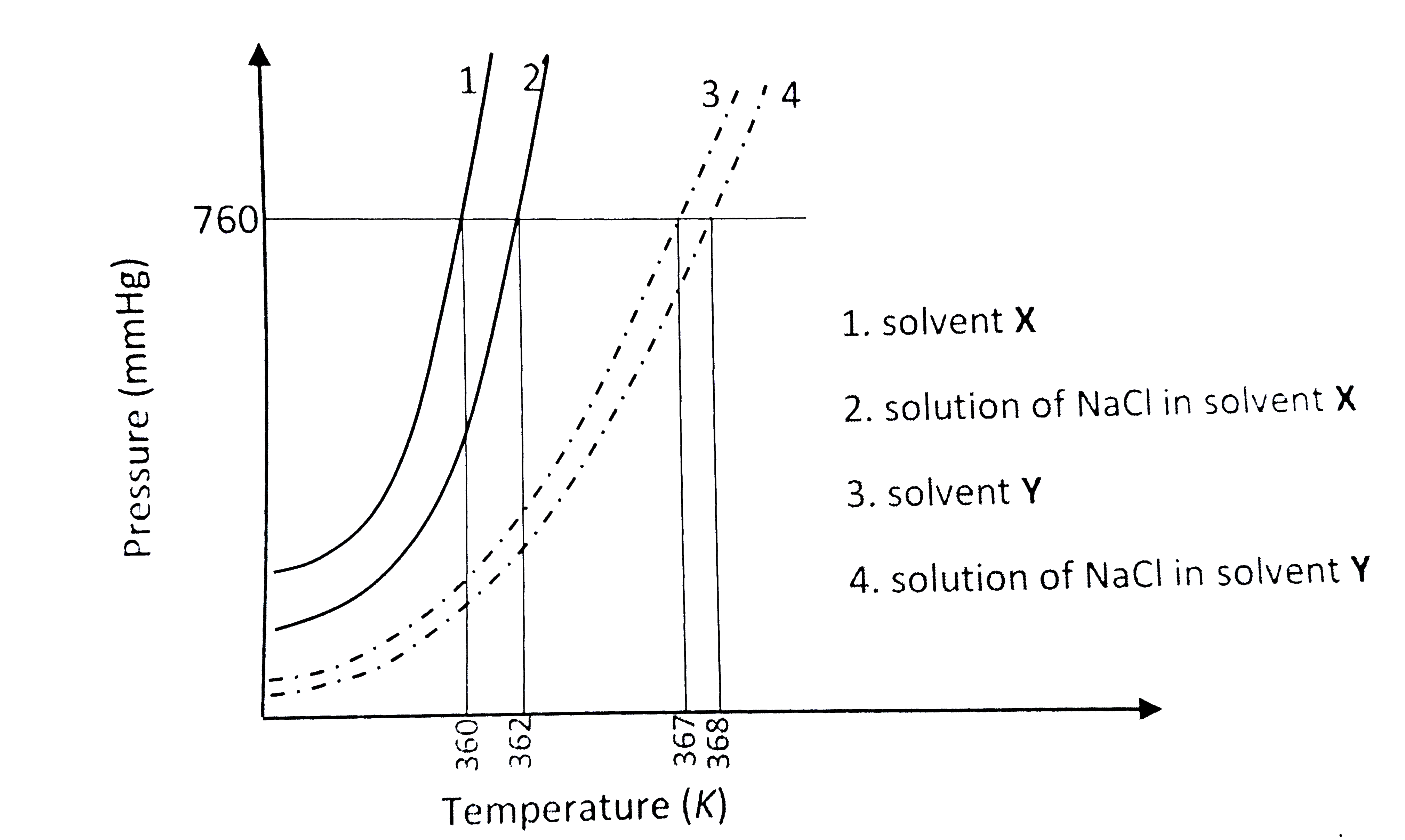The values of Kf for solvents P,Q,R and S are 1.86, 1.99, 5.12 and 4.7 kg mol−1 resp. The equimolal solutions of a solute in these solvents will have the freezing point in order of solvents
RgtSgtQgtP
PgtRgtSgtQ
PgtQgtSgtR
RgtQgtPgtS
The correct Answer is:C
Higher value of Kf lower is the freezing point of solution for given molality.
Topper's Solved these Questions
- BOOK - NIKITA PUBLICATIONCHAPTER - SOLUTION & COLLIGATIVE PROPERTIES EXERCISE - Questions from Competition Exam43videos
SOLUTION & COLLIGATIVE PROPERTIES
- BOOK - NIKITA PUBLICATIONCHAPTER - SOLUTION & COLLIGATIVE PROPERTIES EXERCISE - Questions from Competition Exam43videos
SOLUTION & COLLIGATIVE PROPERTIES
- BOOK - NIKITA PUBLICATIONCHAPTER - SOLID STATE EXERCISE - Question from Competition Exam39videos
SOLID STATE
Similar Questions
The plot given below shows P−T curves (where P is the pressure and T is the temperature) for two solvents X and Y and isomolal solutions of NaCl in these solvents. NaCl completely dissociates in both the solvents.

On addition of equal number of moles of a non-volatile solute S in equal amount (in kg) of these solvents, the elevation of boiling point of solvent X is three times that of solvent Y. Solute S is known to undergo dimerization in these solvents. If the degree of dimerization is 0.7 in solvent Y, the degree of dimerization in solvent X is ____.View SolutionThe plot given below shows P – T curves (where P is the pressure and T is the temperature) for two solvents X and Y and isomolal solutions of NaCl in these solvents. NaCl completely dissociates in both the solvents.

On addition of equal number of moles of a non-volatile solute S in equal amount (in kg) of these solvents, the elevation of boiling point of solvent X is three times that of solvent Y. Solute S is known to undergo dimerization in these solvents. If the degree of dimerization is 0.7 in solvent Y, the degree of dimerization in solvent X is ______________.View Solution
Knowledge Check
- Question 1 - Select One
The value of Kb for a solvent is X K kgmol−1 A 0.2 m solution of a non-electrolyte in this solvent will boil at ___ .( Given : boiling point of solvent =A∘C)
A(A+X)∘CB(A+X10)∘CC(A+X5)∘CD(A+X5)K - Question 2 - Select One or More
0.05 m urea solution will have freezing point (Kf = 1.86 K kg mol−1 )
A273.093 KB273.186 KC272.907 KD272.814 K - Question 3 - Select One
The molal depression constant for a solvent is 4.9. The depression in freezing point for a millimolal solution of a non-electrolyte in the solvent is
A0.49B4.9C4.9 + 0.001D0.0049.
An aqueous solution of 0.1 molal concentration of sucrose should have freezing point (Kf=1.86Kmol−1kg)
View SolutionNormal freezing of a solvent is 5∘C. A 0.5 molal solution of urea in this solvent causes a freezing point depression of two degree. Calculate molal depression constant. (Kf)
View SolutionCalculate elevation in boiling point of final solution (in kelvin) obtained after removal of of solid solvent from a solution having 1 mole of non-volatile non electrolyte solute in 1000g solvent and cooled to a temperature of 3∘ C below the freezing point of solvent .
Given : Cryoscopic constant of solvent =1.5 K kg mol−1 and ebullioscopic constant of solvent = 1 K kg mol−1.View SolutionAn aqueous solution of 0.1 molal concentration of sucrose should have freezing point (Kf=1.86Kmol−1kg)
View SolutionIn a 0.5 molal solution KCl, KCl is 50% dissociated. The freezing point of solution will be (Kf = 1.86 K kg mol−1):
View Solution

